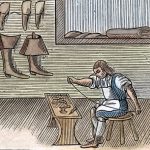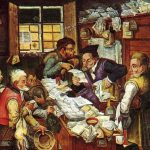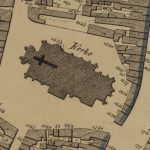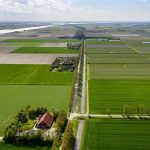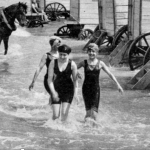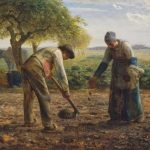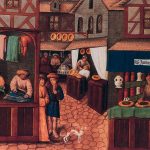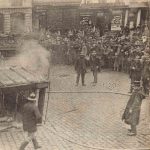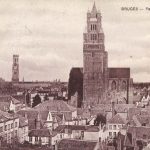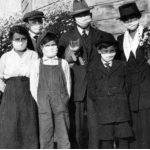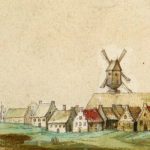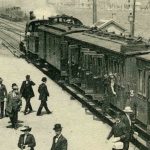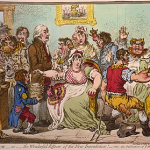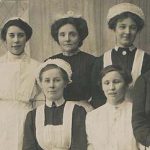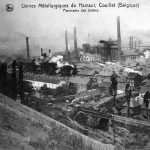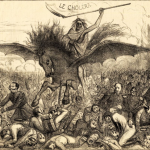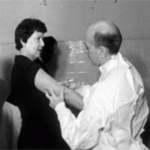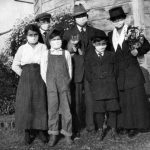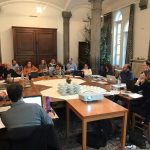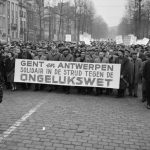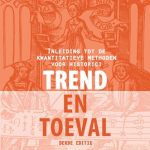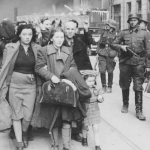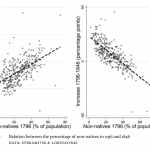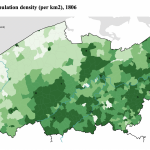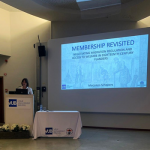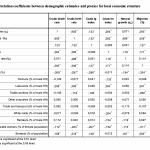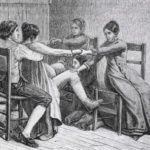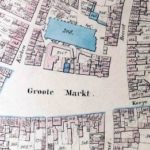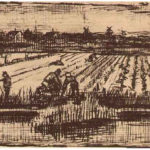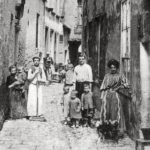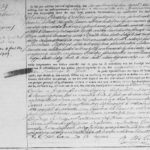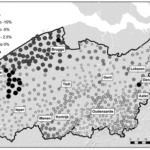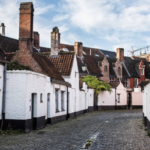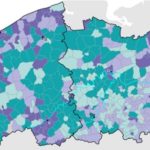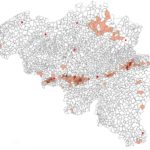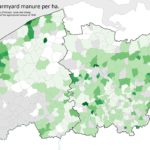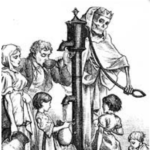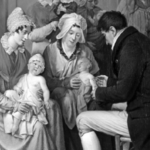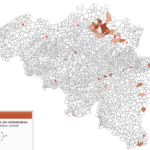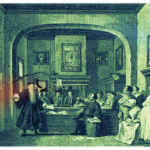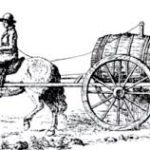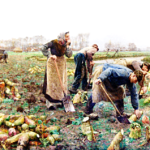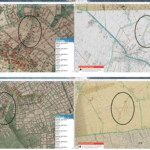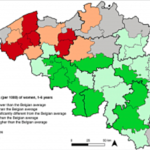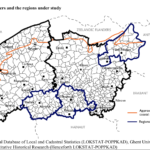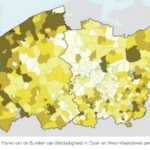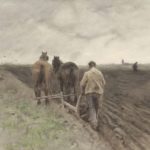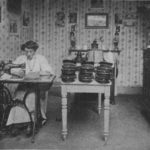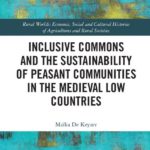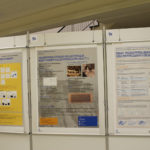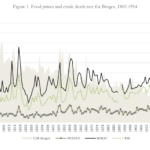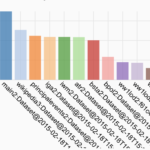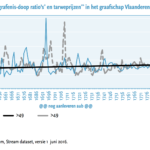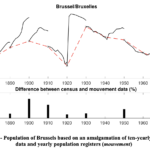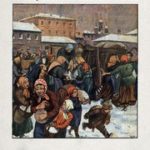News
How was industry faring in Flanders in the first half of the 18th century? Researchers Wouter Ryckbosch and Anne Winter (VUB) analyzed industrial production and labor using the industrial survey of 1738 from the STREAM database.
S.O.S. Antwerp, a citizen science project of the Quetelet Center, is honored with an award during the annual science communication awards ceremony by the Royal Flemish Academy of Belgium.
What role did capital play in the development of the Southern Netherlands? Nicolas De Vijlder unravels in his doctoral thesis the interaction between land and credit markets, analyzing their impact on overall socio-economic relations. For this research, he relied on datasets from LOKSTAT and POPPKAD.
POPPKAD, the database of the Belgian cadastral records from the nineteenth century, surpasses the milestone of 10,000 users, setting a new record. The infrastructure is reaching a wide audience.
We are looking for two PhD students to help research the evolution of social inequality in mortality in the nineteenth and twentieth centuries based on the S.O.S. Antwerp database.
Apply now: https://ap.lc/NaOg8 (UGent) and https://ap.lc/sTQXF (UAntwerpen)
Isabelle Devos of the Quetelet Center is co-promoter of the COST action ‘The great leap. Multidisciplinary approaches to health inequalities, 1800-2022 (GREATLEAP)’, an interdisciplinary research network exploring the historical roots and drivers of health inequalities between regions and countries in Europe and beyond.
Taxes have always played an important role in the finances of early modern farming. Especially in times of war, taxes had a very heavy impact. To finance warfare, (occupying) governments often raised taxes drastically. So high that they caused bankruptcies among farmers. Sander Berghmans (UGent) shows how taxes played a role in the scaling-up of farms in coastal Flanders (17th and 18th centuries). STREAM provided contextual data for this research.
The summer of 2022 was again hot and dry, with a heat wave from 9 to 16 August. That heatwave caused additional deaths. Wouter Ronsijn investigates whether this was also the case in the past. He links data from the S.O.S. Antwerp database to temperature data in Uccle for the period 1833-1946 and reaches some interesting observations.
For centuries, common lands played a key role in the survival strategies of local communities in Western Europe. The modernization of the countryside in the 18th and 19th centuries was accompanied by the disappearance of these lands and rights that were used in common. Esther Beeckaert (UGent) investigated how this far-reaching and complex process took place in the Belgian Ardennes. In October she will publicly defend her PhD, which is partly based on LOKSTAT.
What was the death toll in Belgium through World War I and World War II? Which war cost the most lives? Surprisingly, there is still uncertainty about this. Historian Bruno De Wever (UGent) calculated the number and received help from the Quetelet Center.
Landlessness is a phenomenon of all times and places. In the past, it was usually synonymous with poverty because without a patch of land to cultivate, many families were unable to provide for themselves. Flanders experienced mass landlessness in the mid-19th century due to an economic crisis that affected large parts of the population. During the second half of the century, the number of families with access to land grew again. This is one of the conclusions of a study conducted by Wouter Ronsijn (UGent) using LOKSTAT.
Nowadays, the flower market of Ghent, the bird market of Antwerp and the antiques market of Tongeren are mainly tourist attractions, but where could one go in the past for the weekly market? In the previous blog post, Wouter Ronsijn (UGent) showed how many markets were held in the county of Flanders during the early modern period. In this month’s contribution we learn where markets used to be organised and how this pattern evolved over time.
The Ghent flower market celebrates its 250th anniversary this year and is probably the oldest flower market in Flanders. Apparently, flowers were first sold on Ghent’s Kouter square by the horticulturalist Toontje Verstuyft in 1772 on the first Sunday in June. Until the late twentieth century, local weekly markets played a central role in the economic and social life of village and urban dwellers. In those days, people could buy not only flowers but also a wide variety of products. Wouter Ronsijn (UGent) has used the STREAM database to reconstruct the development of weekly markets in the county of Flanders between ca. 1550 and 1800. Where could people go? And on which days?“
The modernisation of society from the 19th century onwards was not without its problems. In cities, they led to tensions between population groups who wanted to make their ideas dominant through street protests and violence. In a recently submitted doctoral dissertation, historian Martin Schoups examines these actions in the city of Antwerp between 1884 and 1936 and shows which fault lines lay at the basis of them. For this, he used among other things contextual data from LOKSTAT.
Which plants grew in the East Flanders countryside two centuries ago? How is the wild flora today compared to that time? Biologist Katrijn Vannerum and historian Thijs Lambrecht (UGent) investigated the development of plant diversity using the herbarium of Charles Van Hoorebeke and consulted LOKSTAT.
The POPPKAD database continues to attract a large number of users. The Quetelet Center will expand the database further in 2022 with the cadastral data of almost all West Flemish municipalities from the middle of the 19th century. These data will become available thanks to the project West-Vlaanderen Verpoppt in which dozens of volunteers are collaborating.
More than 100 years after the pandemic, the very first (!) scientific article about the Spanish Flu in Belgium was published this month. Three databases of the Quetelet Center (LOKSTAT, HISSTER and S.O.S. ANTWERP) provided essential material for this overview.
Studies on the nineteenth century past of Ostend are rare. Recently, Luc François (Prof. em. UGent) and Pieter François (University of Oxford) published a remarkable study on the earliest cadastral register of Ostend. They analyse the spatial planning, the buildings, the distribution of wealth and the distribution of the population in unprecedented detail on the basis of cadastral data that were converted into detailed maps by the Quetelet Center.
Mills are back. After disappearing for centuries, these sources of power are rising from the ground everywhere and making a valuable contribution to energy consumption. In the past, these tools also determined the rural appearance of Flanders. The Quetelet Center has made a unique survey map of the distribution of mills around 1774.
During the nineteenth century, Belgium underwent a transformation from a country with modest mobility to an area with intense commuting and transport movements. Ingrid Schepers (UA) investigates the impact of transport policy on labour mobility and shows how access to the transport network played a key role in spatial planning and the development of society.
The vaccination campaigns against covid-19 are in full swing in Belgium, but are not going smoothly everywhere. There are large differences between municipalities. This was also the case for the first vaccinations against smallpox, some two centuries ago. Only the relationship was the other way around: the highest vaccination coverage was recorded in the poorest regions.
Research into economic activities across generations has long been limited to sons, despite the importance of female employment. Vincent Delabastita and Erik Buyst (Dep. of Economics KULeuven) investigated the extent to which fathers and sons as well as mothers and daughters exercised the same profession. Their analysis, for which LOKSTAT provided contextual data, shows clear differences between the sexes.
In the nineteenth century, the migration flows increased enormously. Journalist and historian Ellen Debackere studied the immigration policy in the city of Antwerp from 1830 to 1880 and shows how much the policy priorities differed from those of the national state. Her research is based in part on figures from LOKSTAT.
At the end of October 2020, the Quetelet Center launched the citizen science project S.O.S. Antwerp (Social Inequalities at Death (1820-1946). What did the people of Antwerp die of?). In this project, the data of the unique handwritten cause-of-death register of the city of Antwerp are entered into a digital database by volunteers working at home.
At the end of December 2020, Belgium started the vaccination campaign against COVID-19. This is more than two centuries after the very first vaccine was administered. Back then, it concerned smallpox, the only disease for which a vaccine was developed and rolled out on a large scale in Europe as early as the nineteenth century. Although Belgium was one of the pioneers of smallpox vaccination, it failed to introduce compulsory vaccination against the disease in the nineteenth century, unlike almost all other European countries.
Industries come and go. What determines the success of regions in acquiring and retaining new and old industries from 1800 to today? And how do industrialization processes proceed? By means of case studies in Europe and Asia, an international team of researchers, including economists from Ghent University, sought an answer to these topical questions. The book was recently published with the research results to which LOKSTAT made a substantial contribution.
Land-based
capital played a key role in Flanders’ economic growth. Nicolas De Vijlder and
Koen Schoors (UGent) came to this conclusion after analyzing data from LOKSTAT
and POPPKAD in the period 1830-1910. Their findings make a valuable
contribution to the international debate on economic growth.
Belgium was
at the forefront of industrial development in the world in the 19th century.
Which factors explain this success? In search of the answer, economist Franz
Zobl of the London School of Economics (LSE) consulted LOKSTAT.
In 1866, a severe cholera epidemic raged across Belgium. The city of Brussels was hardest hit, with 3,469 deaths from the disease. During the epidemic, various kinds of statistical data were collected by the city council. The Quetelet Center has linked this information with some of its databases, and so succeeded in reconstructing the course of the epidemic in the capital and determining who its main victims were.
The excess mortality due to Covid-19 In Belgium made April 2020 the deadliest April month since World War II. In the past, common flu epidemics also caused increased mortality rates. Patrick Deboosere, demographer at the VUB’s Interface Demography, shows how these epidemics were dealt with in Belgium and uses figures from the HISSTER database.
The coronavirus is currently spreading across the world. Yet, it is not the first epidemic to sweep the globe. The Black Death and the Spanish Flu are well known, but what other disease outbreaks have shaped Belgian history? Isabelle Devos (Ghent University, History Department) brushes up your knowledge in 2500 words and a short video.
In an article in the newspaper De Standaard on 20 April, the journalist Marc Reynebeau states that the Spanish Flu epidemic of 1918-19 cost the lives of almost 300,000 Belgians and discusses why in the past there was so little attention paid to the epidemic in Belgium. Based on a study of the literature and the HISSTER database of the Quetelet Center, Isabelle Devos (History Department, Ghent University) questions these numbers and points to the need for historical criticism when using figures.
During the 1840s, Belgium underwent a deep crisis after a series of crop failures. The effects of the recession varied greatly from region to region. Esther Beeckaert and Eric Vanhaute (Department of History, Ghent University) investigate these regional differences and come to an explanation for the varying impact of the crisis.
On January 29, historian Jan Naert successfully defended his doctoral thesis at the UGent about the mayors in occupied Belgium and France during the First World War. The Quetelet Center cooperated in the research project.
On 10 January the Quetelet Center organised the fourth workshop of the SHiP network (Studying the history of Health in Port cities). This international network brings together scholars in social history, historical demography and medical history.
Earlier this year the Flemish Government launched a call for Citizen Science Projects. The call was a great success with 53 projects; 7 projects came out on top. The proposal from the Quetelt Center was selected!
Food supply faced various challenges in the past centuries. The last issue of the CORN publication series is dedicated to this topic from a long-term perspective. It contains contributions on the development of food supply in various countries, including a study on urban agriculture in Belgium based on LOKSTAT and POPPKAD.
What place did the deaf have in eighteenth- and nineteenth-century society? Did they become institutionalised, did they live independently or could they go live with relatives? Sofie de Veirman and Isabelle Devos from Ghent University published their findings on the institutionalisation of deaf persons in eighteenth- and nineteenth-century East Flanders based on the DEAF database in the “Tijdschrift voor Geschiedenis”.
Maayan Mor recently obtained a PhD in Political Science at the University of Wisconsin-Madison. In her dissertation, she investigated the causes of electoral division and, using LOKSTAT, comes to a new explanation for the growing gap between voters.
On September 9th the Faculty of Arts and Philosophy at Ghent University organised a research day. Laura Debyser, doctoral researcher at the Department of History, presented her research on cancer for which she works, among others, with data from the LOKSTAT and HISSTER databases.
Quantitative methods are indispensable for the historian’s craft. In the new edition of the textbook “Trend en Toeval” (third edition) (Trend or Chance), lecturers from Ghent University, University of Antwerp and Vrije Universiteit Brussel offer an accessible introduction to historical statistics. Historical data together with statistical and cartographic tools from the Quetelet Center were used for concrete examples.
Flanders was hit by a major crisis in the 1840s. Famine and poverty plagued large parts of the countryside due to high unemployment, the decline of the linen industry and a series of crop failures. Wouter Ronsijn (Bocconi University of Milan and Ghent University) elaborates on the causes and investigates the key role that food prices and labour wages played in the development of the recession.
Bethune Castle in Marke is the location of the almost completely preserved company archive of the firm Bethune & Fils, the textile company with which the family amassed a fortune. Explore the fascinating world of the textile trade with the help of the database!
Who offered help to the Jews during the Second World War in the Low Countries? Which groups distinguished themselves in the clandestine resistance to the Holocaust? In a recently published book, sociologist Robert Braun from the University of California at Berkeley comes to a remarkable answer with the help of LOKSTAT data.
The STREAM and LOKSTAT databases are bearing fruit: Nick Deschacht (KU Leuven) and Anne Winter (VUB) reinterpret in the Journal of Migration History the mobility transition on the basis of unique data on the composition of the population and the socio-economic structure in East and West Flanders and Antwerp.
Mapping regional patterns in population, welfare and prosperity in early modern Flanders? At the third conference of the European Society for Historical Demography in Pecs (Hungary), Isabelle Devos shows us how to do just that with the database and the corresponding historical geographical information system of the Stream project.
On 31 May, Marjolein Schepers defends her PhD “Membership revisited: negotiating migration regulation and access to welfare in eighteenth-century Flanders” at the Vrije Universiteit Brussel. The Quetelet Center assisted her in the creation of maps based on the LOKSTAT and STREAM databases.
This year’s study week of the Fondazione Istituto Internazionale di Storia Economica F. Datini in Prato (Italy) was devoted to economic inequality in the early modern period. Isabelle Devos, Thijs Lambrecht (Ghent University) and Anne Winter (Vrije Universiteit Brussel) presented their research on regional economies in early modern Flanders. Using Stream datasets, they analysed the relationships between poor relief and demographic behaviour.
Housing rents are consuming an increasing share of the family budget. Rising rental prices mean that many homes have become unaffordable for people on an average income. How far does this trend go back? Was living comparatively cheaper in previous centuries? Three economists from the Universities of Cambridge and Maastricht took a close look at the rental prices of urban housing in Belgium and its neighbouring countries for the period 1500-2017.
On 6 March, Jeroen Cant (Antwerp University, Faculty of Applied Economic Sciences) defended his doctoral thesis on the accessibility of food stores in Flanders. Using various sources, including the LOKSTAT database, he charted the rise of supermarkets and the decline of small grocery stores.
Until the mid-20th century, the majority of births took place at home. So far, there have been few studies on the cost of such a home birth. In the latest issue of Tijdschrift voor Sociale en Economische Geschiedenis (The Low Countries Journal of Social and Economic History), Christa Matthys (Ghent University) adds to our knowledge with research based on the casebook of a rural midwife and data from the LOKSTAT database.
The number of users of the POPPKAD database is growing fast. Based on the latest figures, more than 3000 researchers, local historians and genealogists have found their way to the infrastructure. The database of property owners is particularly popular. To date, no fewer than 15 000 registers have been downloaded through the website.
In the 1850s, Belgium was hit by a food crisis. Wouter Ronsijn and Eric Vanhaute (Ghent University) argue in the latest issue of Agricultural History Review that this crisis was not caused by food scarcity, but by high food prices. They based their research on various sources, including population and poverty figures from the LOKSTAT database.
How dangerous was life in the cities of Brussels, Liège and Schaerbeek in the year 1910? What was the average age at death? Which occupations were most risky? How many children were stillborn? The URBAN DEATHS database brings clarity to these issues.
What was care for people with a disability like in the past? Sofie De Veirman and Isabelle Devos (Ghent University) analysed the role of family in the lives of deaf people in the 19th century. They reconstructed the families of several hundred deaf people, based on population registers and birth, marriage and death certificates. These life courses were collected in the DEAF database and are currently managed by the Quetelet Center.
To what extent does government policy impact epidemic outbreaks such as rinderpest? Adam Sundberg (Creighton University) and Filip Van Roosbroeck (Antwerp University) recently joined forces to answer this question for the rinderpest outbreak of 1769-1785. They worked with data from different sources, including data on livestock and land use from the LOKSTAT and POPPKAD databases.
In order to gain an insight into gender relations, the economists Annalisa Frigo and Eric Roca of the Institute of Economic and Social Research (IRES) set to work with data from the LOKSTAT database to study the composition of the population between 1846 and 1961.
Poor care existed in many forms in early modern Flanders. In the last issue of the journal Continuity and Change, Nick Van Den Broeck, Anne Winter (Vrije Universiteit Brussel) and Thijs Lambrecht (Ghent University) study the regional differences in poor care in rural areas, based on data from the STREAM database The Quetelet Center also created the maps.
There are a number of freely available censuses on the LOKSTAT website, which you can consult in an interactive way. Try your hand at making your own maps based on the industrial census of 1896.
In the journal Continuity and Change, Pieter De Graef (Antwerp University) discusses how new fertilisation strategies in the 18th century had a major impact on agricultural productivity. He based his study on a range of sources, including data from the agricultural census of 1846 and the earliest cadastral data from the POPPKAD database. These datasets are managed by the Quetelet Center.
On 26 September, Tina Van Rossem defends her doctoral dissertation, entitled “Bruxelles ma belle. Brussels mortelle: an investigation into excess mortality in Brussels at the turn of the twentieth century”, at the Vrije Universiteit Brussel (VUB). In addition to the dissertation, her research led to the creation of the URBAN DEATHS database, which the Quetelet Center has made available for further scientific research.
What was the impact of the smallpox virus on the height of the population in 19th-century Belgium? Historians Ans Vervaeke (Vrije Universiteit Brussel) and Isabelle Devos (Ghent University) looked for the answer to this question by using the LOKSTAT and STREAM databases and published their findings in a special issue of The Low Countries Journal of Social and Economic History devoted to diseases.
The results of some important censuses can be freely consulted on the LOKSTAT website. The historian and journalist Pieter Neirinckx worked with these rich sources to obtain an overview of the economy in Genk at the end of the 19th century. Read on to find out how you too can start working with these data.
On 18 June, Ans Vervaeke defends her doctoral dissertation, entitled “Met recht en rede(n). Toegang en gebruik van burgerlijke rechtbanken in het Brugse Vrije (1670-1795)” (“With good reason(s). Access and use of civil courts in the Franc of Bruges (1670-1795)”), at the Vrije Universiteit Brussel (VUB). This work examines the impact of socio-economic changes on patterns of litigation based on some of the STREAM datasets. The Quetelet Center produced the maps for the dissertation.
On Tuesday 29 May, Maja Mechant of Ghent University defends her doctoral dissertation on prostitution and the life courses of prostitutes in 18th-century Bruges. Her doctorate led to the creation of the PROST database, which is accessible through the Quetelet Center as from today!
The reuse of organic urban waste as agricultural fertiliser is often put forward as a solution for closing the nutrient cycle between the city and the countryside. Using statistics from the POPPKAD and LOKSTAT databases, Pieter de Graef refutes the existence of such cradle-to-cradle systems in the pre-industrial era in an article in the Journal for the History of Environment and Society.
In an article in the International Journal of Humanities and Arts Computing, the interdisciplinary team that created the STREAM database explains how the database came into existence, which sources were used and how the historical geographic information system was constructed. Click through and discover how STREAM can help take your research forward.
How did women in the 18th and 19th centuries survive without a spouse at their side? Did they live alone, in a family context or did they create a household with unrelated people? Were they more numerous in the city or in rural areas? What jobs did they do? Check out the SINGLE database to find out more.
In the STREAM project, an interdisciplinary team of geographers and historians from Ghent University and the Vrije Universiteit Brussel (VUB) collaborates on developing tools which can quickly and easily convert old maps into geographical databases. Would you like to know how these systems work and what you can do with them?
New research based on historical data from LOKSTAT and other databases shows that people who grow up in an urban environment have an increased risk of having less grey matter in the brain than people raised in rural areas. The research was conducted by Dutch psychologists and psychiatrists from Utrecht University and the School for Mental Health and Neuroscience at Maastricht University.
The Quetelet Center manages five interactive applications that were developed based on the historical cadastre published by P.C. Popp. GIS technology helps to bring the past – landscapes, roads, houses, buildings and property relationships – back to life.
What was the regional distribution of mortality risks in Belgium in the early 20th century? In the interdisciplinary journal Espace, Populations, Sociétés (Space, Populations, Societies), sociologists Tina Van Rossem and Patrick Deboosere, together with our own Isabelle Devos, tackle this question with the help of data from the HISSTER database.
For a long time, mortality rates in the Westhoek were twice as high as in the rest of the country, a phenomenon that continued until the beginning of the 20th century. Why this was so can be explained with the help of data from the LOKSTAT and HISSTER databases. Journalist Kristof Clerix unravels the case in an article that recently appeared in the magazine Knack.
Adolphe Quetelet, the founder of modern statistics, is commemorated in February, the month of both his birth and his death. So now is the ideal occasion to examine what made this man so extraordinary! The university student magazine Schamper consulted the Quetelet Center.
Ghent historian Wouter Ronsijn recently presented his research into land ownership in 19th-century Flanders at the biennial European Rural History Conference. Thanks to the LOKSTAT and POPPKAD databases, he was able to carry out a detailed analysis of land ownership and land use in Belgium during the 19th century, present the findings on a map, and refine and nuance existing knowledge about 19th-century impoverishment.
Between 1840 and 1880 P.C. Popp published one of the most remarkable reference works on property that had ever appeared in Belgium, the cadastral atlas of Belgium. Quetelet staff member Sven Vrielinck unravels the many mysteries surrounding this publication in his recently published book Grootse Plannen (Grand Plans).
How was poor relief organised in the past? Historians Thijs Lambrecht (Ghent University) and Anne Winter (Vrije Universiteit Brussel) use a survey made available through the STREAM database, which was conducted by the French regime in 1808 in the Scheldt and Leie departments, to estimate the resources that were available then for poor relief.
People with disabilities are an integral part of every society. Nevertheless, we know very little about the experiences and life courses of persons with disabilities in the past. The DEAF database is now available and offers a unique insight into how men and women who were born deaf shaped their lives in the long 19th century.
During the 19th century, the standard of living of the rural population in Flanders rose despite many setbacks. In a recent issue of Tijdschrift voor Sociale en Economische Geschiedenis (Journal of Social and Economic History), the Ghent historian Ewout Depauw shows, based on the height of prisoners, that there were indeed important regional differences in the development of living standards. He does this using figures from various sources, including the LOKSTAT database.
Was the domestic industry in Belgium the most murderous of all industries? In order to answer this question, Tina Van Rossem, Patrick Deboosere (Vrije Universiteit Brussel) and Isabelle Devos (Ghent University) examined mortality rates and industrial employment for the 25 largest cities in Belgium, based on data from the HISSTER database. They present their results in the journal Explorations in Economic History.
The recently published book Inclusive Commons by historian Maïka De Keyzer (KULeuven) examines property rights and common land in the medieval Campine area. De Keyzer used 19th-century surface area data from the LOKSTAT database, among other things, to reconstruct population densities for the Southern Netherlands in the Middle Ages.
A memorandum on the building permit policy in Flanders was recently produced for the Flemish Planning Bureau for the Environment and Spatial Development (VPO). This used municipal population figures for the period 1965-1981 from the LOKSTAT database.
On Wednesday 29 November, the Faculty of Arts and Philosophy of Ghent University organised its very first Research Day. We joined in and presented the STREAM data infrastructure during the poster session. Look at the poster and discover which sources are held in the database and the research applications!
The HISSTER database provides a selection of mortality statistics for Belgian municipalities for the period 1841-1976. The database was developed to protect Belgium’s rich heritage of mortality statistics contained in the archives of “Mouvement de la Population et de l’Etat Civil”, and to make the data available for research. The Mouvement is a unique series of registers, filled in by hand, of the annual changes in the population. Discover for yourself the possibilities of this dataset.
In a recent article in the authoritative The Economic History Review, economist Deborah Oxley (Oxford University) and historian Ewout Depauw (Ghent University) investigate the link between the development of living standards and the height of adult men. They use mortality data from the LOKSTAT database, among other things, to show that living conditions during puberty have a greater influence than those during early childhood on growth and the final height in adulthood.
In this reference book, historians and archivists from various Belgian institutions present an overview of the sources that are preserved in Belgium concerning its turbulent wartime past. The Quetelet Center has constructed various maps showing repression and the judicial organisation in Belgium, based on territorial data from the LOKSTAT database and data provided by the authors.
Computer scientists and historians from the Swedish Aalto University and the American University of Colorado Boulder recently joined forces and were grateful for the opportunity to use territorial maps of Belgium in 1916, provided by the Quetelet Center from the LOKSTAT database, for the creation of the World War I Linked Open dataset. The dataset links and makes available information about the First World War from primary sources.
The preservation of our collective past is a daily challenge for archivists. In a new handbook, historian Ine Coessens and computer architecture researcher and practitioner Wim Heirman provide some basic principles for a carefully considered selection of data, based on the BETHUNE database managed by the Quetelet Center.
Early modern cities were characterised by an unhealthy living environment and high mortality rates. But how were things in rural areas? The Ghent historian Isabelle Devos and Brussels sociologist Tina Van Rossem examined regional differences in mortality rates, using a STREAM dataset, and recently published the results in De Zeventiende Eeuw (The Seventeenth Century) yearbook.
The MAID database is now available through the Quetelet Center. In this database you will find data on individual female domestic servants who migrated from the countryside to the city of Ghent in the course of the 19th and early 20th century. The database was compiled by Christa Matthys as part of her doctoral research into the fertility transition in Flanders.
In the latest issue of the journal Historical Methods, Ghent economists Stijn Ronsse and Samuel Standaert illustrate the advantages of state-space models in reconstructing reliable long-term data series, using annual population figures for Belgian municipalities from the LOKSTAT database.
In Famine in European History, an international overview published by Cambridge University Press, historians Daniel Curtis, Jessica Dijkman, Thijs Lambrecht and Eric Vanhaute use population statistics from the LOKSTAT database for their analysis of living standards in the Low Countries.
The Quetelet Center was launched in the spring of this year. After a short preparation period, we are now proud to present our website. The center is one of the 15 expertise centers across the university that makes the knowledge and data developed at Ghent University accessible to the research community and the general public.
